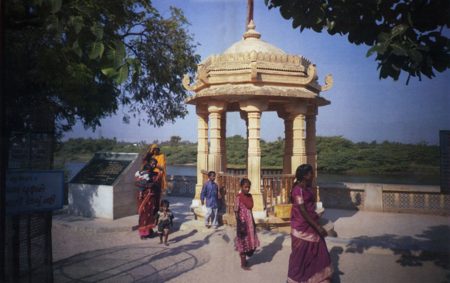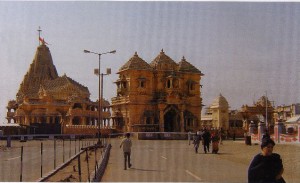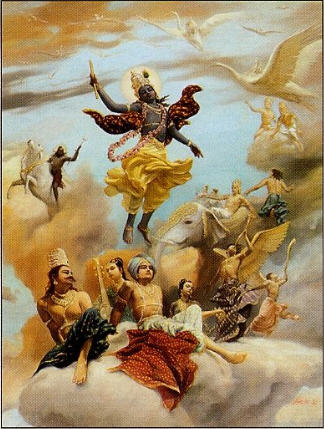South along the coast from Lord Krsna's city of Dwarka lies the sacred area where He closed the curtain on His earthly drama.

The city of Somnath lies on the west coast of India, in the state of Gujarat. The area was formerly called Prabhasa, and it was here that Lord Krsna arranged for the members of His dynasty to leave this world, on the pretext of killing one another in a great battle.
The main temple at Somnath is that of Lord Siva as Somesvara, "the lord of Soma, the moon-god." (Somnath, from soma-natha, means the same thing.) At the entrance to the temple, I was welcomed not by priests but by four police officers, stationed there because of recent terrorist attacks in Gujarat. I encouraged them by telling them that by protecting the temple they were performing the real duty of the ksatriya, or administrative, class.
As is common in Siva temples, the deity is a Siva-linga, a phallic representation of Siva as the original progenitor. According to the Siva Purana and Nandi Upa-Purana, Lord Siva is especially present on earth in twelve places. The Siva-lingas in these places are known as Jyotir-lingas ("lingas of light"), and the foremost of these is Somesvara at Somnath.
To see Somesvara, I passed through two impressive pillared halls. The Jyotir-linga looked like other Siva-lingas I'd seen, but the priest told me that a person who has attained a certain degree of spirituality sees the Jyotir-linga as a column of fire piercing through the earth. Many people were visiting the temple, most of them to perform the sraddha ceremony for the sake of their ancestors.
Outside, from the back of the temple I had a beautiful view of the ocean and the beach. Local people sold conch shells and small sculptures of deities, and pilgrims enjoyed riding on horses and camels.
When I returned to the police stand to retrieve my bags, an officer, pleased by my previous words of sincere praise, told me some history of the Somnath temple's repeated destruction. He compared the temple to the mythical Phoenix, a bird that burns up but leaves behind an egg so that another Phoenix can rise.
"Similarly" he said, "this temple, with the deity whose shape is like that of an egg, has risen eight times after being plundered and reduced to ruins between A.D. 1300 and A.D. 1707."
While excavating for the present temple, workers found the remains of many former temples. Unearthed sculptures, artistic pillars, ceilings, and inscriptions are displayed in the Prabhas Patan museum in town. The original temple is said to have been built in four phases. Soma, the moon-god, built it out of gold; Ravana, the enemy of Lord Rama, rebuilt it out of silver; Lord Krsna rebuilt it out of wood; and the Pandava Bhima rebuilt it out of stone.
References to Prabhasa can be found in the ag Veda and in several Puranas. The Srimad-Bhagavatam (Bhagavata Purana) mentions that Lord Balarama came here twice, once when He went on pilgrimage to avoid taking sides in the Battle of Kurukshetra, and again, on the request of sages, after He killed the disrespectful Romaharsana Suta.
At Prabhasa Arjuna heard that Lord Balarama was arranging the marriage of Subhadra to Duryodhana. Disguising himself as a mendicant, Arjuna went to Dwarka and eventually won Subhadras hand.
Origin of the Temple Deity

The story of Candra's installation of Somesvara is found in the Skanda Purana and the Mahabharata. Although Candra, the moon-god, was married to all twenty-seven daughters of the progenitor Daksa, he was partial to Rohini, keeping her always with him and neglecting the others.
Annoyed, the other twenty-six wives complained to their father. After repeated warnings, Daksa cursed Candra to suffer from tuberculosis, lose his beauty and radiance, and wane into nothingness. Candra's affliction disturbed the tides and the growth of vegetation. Sages asked Daksa to withdraw his curse, but he said he didn't have the power to do so. He advised Candra to take refuge in Lord Siva. Candra came to Prabhasa with his wife Rohini, found the Jyotir-linga here, and worshiped Lord Siva in that form. Pleased, Lord Siva blessed Candra with fortnightly phases of waning and waxing. Because the moon regained his growth and light here, the place became known as Prabhasa ("to shine").
While riding on the two-wheeled horse carriage from Somnath to the Gita temple, I passed by the Surya (sun) temple and Pandava-guha, a cave associated with Pandavas, who according to the Mahabharata did penance at Prabhasa. In the Gita temple, I saw the deity of flute-playing Krsna. On the right side of the temple in a small attached shrine is a deity of Lord Balarama with Ananta Sesa, His expansion. This is considered the site where Lord Balarama departed from the earth. Next to Balarama's shrine is a Laksmi-Narayana temple. A room used by Vallabhacarya, founder of the Pusti Marga spiritual line, is in a courtyard nearby. His followers worship this place.
Opposite the Laksmi-Narayana temple is the confluence of three rivers: the Hiranya, the Kapila, and the now dried up Saraswati. Lord Krsna left the earth from this spot. His footprints in marble are installed in a small open shrine.
On the way to Veraval, a larger city six kilometers northwest of Somnath, I stopped in Bhalka village to visit a Krsna temple known as Bhalka Tirtha. The temple is built around the tree under which Krsna was sitting when Jara the hunter shot an arrow into His foot. On the left side of the tree is a white marble altar on which Lord Krsna is sitting. His pink foot points toward Jara, who kneels with folded hands. At this spot Lord Krsna spoke His final instructions to Uddhava. [See "The Song Goes Ever On," page 25.]
I was encouraged at Somnath to see that brahmanas and ksatriyas are preserving and protecting sanatana-dharma eternal religious principles. The government of Gujarat is protecting the temples, which were repeatedly raided by invaders and face the same threat today. And Vaisnava priests of the Vallabha line are preserving authentic spiritual knowledge, which is always threatened by the misinterpretations of atheists.
Adbhuta Hari Dasa joined ISKCON in 1994 in Croatia. He serves as personal assistant to his spiritual master, Sridhara Swami.
Visiting Somnath

How to Get There
The nearest airport, in Keshod, about sixty kilometers away, has daily flights from Mumbai.
A train from Ahmedabad takes about twelve hours, from Mumbai about eighteen hours.
There are buses to Somnath from all over Gujarat. Dwarka is seven hours by bus.
Where to Stay
Somnath is a small town with basic rooms available in a few hotels. Visitors usually stay in nearby Veraval. Hotels in Veraval: Satkar Hotel (phone: 20120), Hotel Kasturi (20488), Hotel Ajanta, and Toran Tourist Bungalow.
For more information, consult Holy Places and Temples of India, by Jada Bharata Dasa, available from the Krishna.com Store.
Lord Krsna's Disappearance
"Sukadeva Gosvami said: Then Lord Brahma arrived at Prabhasa along with Lord Siva and his consort, the sages, the Prajapatis, and all the demigods, headed by Indra. The forefathers, Siddhas, Gandharvas, Vidyadharas, and great serpents also came, along with the Caranas, Yaksas, Raksasas, Kinnaras, Apsaras, and relatives of Garuda, greatly eager to witness the departure of the Supreme Personality of Godhead. As they were coming, all these personalities variously chanted and glorified the birth and activities of Lord Sauri [Krsna].

"O King, crowding the sky with their many airplanes, they showered down flowers with great devotion. Seeing before Him Brahma [the grandfather of the universe] and the other demigods [who are all His personal and powerful expansions], the Almighty Lord closed His lotus eyes, fixing His mind within Himself, the Supreme Personality of Godhead.
"Without employing the mystic agneyi meditation to burn up His transcendental body, which is the all-attractive resting place of all the worlds and the object of all the worlds and the object of all contemplation and meditation, Lord Krsna entered into His own abode.
"As soon as Lord Sri Krsna left the earth, Truth, Religion, Faithfulness, Glory, and Beauty, immediately followed Him. Kettledrums resounded in the heavens and flowers showered from the sky.
"Most of the demigods and other higher beings led by Brahma could not see Lord Krsna as He was entering His own abode, since He did not reveal His movements. But some of them did catch sight of Him, and they were extremely amazed.
"Just as ordinary men cannot ascertain the path of a lightning bolt as it leaves a cloud, the demigods could not trace out the movements of Lord Krsna as He returned to His abode.
"A few of the demigods, however notably Lord Brahma and Lord Siva could ascertain how the Lord's mystic power was working, and thus they became astonished. All the demigods praised the Lord's mystic power and then returned to their own planets.
"My dear King, you should understand that the Supreme Lord's appearance and disappearance, which resemble those of embodied conditioned souls, are actually a show enacted by His illusory energy, just like the performance of an actor. After creating this universe He enters into it, plays within it for some time, and at last winds it up. Then the Lord remains situated in His own transcendental glory, having ceased from the functions of cosmic manifestation." (Srimad-Bhagavatam 11.31.1-11)
Unfortunately, nowadays some people and some tourist publications try to diminish Lord Krsna's glories by treating His disappearance pastimes like the activities of an ordinary human being and using phrases like "breathed his last" and "renounced his mor-tal human form." By such disinformation, they misguide sincere pilgrims to Somnath. Guided by pure devotees like Srila Prabhupada, we should value and glorify the Lord's departing pastimes, which are as inconceivably wonderful as all His other acts.
